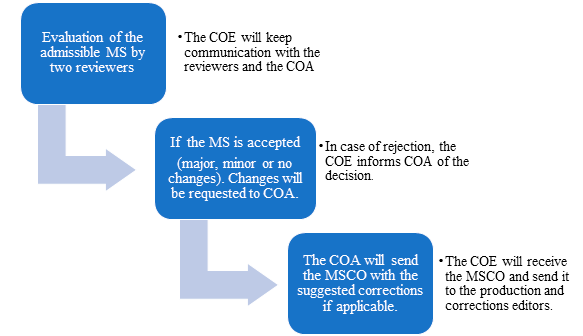Evaluation Process and Document Publication
The author must submit the paper (MS) through the official journal web page (http://www.analesdelinstitutodelapatagonia.cl/). Papers sent by email to the Editor-in-Chief will not be accepted.
Upon receipt, the Open Journal System (OJS) page will deliver an automatic response of receipt, which is not an indication that the paper has passed the evaluation phase.
Admissibility Stage
Manuscripts will be subject to an admissibility evaluation by the Editorial Committee, which may decide whether the manuscript is admissible or inadmissible according to the following criteria: AIP thematic scope, data strength, and presentation of the manuscript. Those papers considered imprecise or inappropriate will not continue the process and will be remitted to their corresponding author (COA) within 48 hours. On the contrary, if your paper is admissible to be sent for peer review, the Editorial Committee may also decide to change the type of a contribution (from full paper to Scientific Note or vice versa.)
After this stage, an Editor in Charge (ECO), who will be responsible for managing the MS, will be assigned. The ECO may be the AIP Editor-in-Chief, Co-Editors, guest editors, or associate editors

Fig. 1. AIP admission stage diagram.
Evaluation Stage
Manuscripts that meet AIP's editorial criteria will be sent for an external review. Our evaluation process establishes that the reviewers remain anonymous to each other and the author. Acceptance or rejection of the manuscripts is the decision of COE based on the reviewer´s recommendations. If the evaluation period has expired and there is only one evaluation completed, the COE may choose to send the manuscript to a third reviewer or ask a member of the Editorial Committee to evaluate it.
If the two reviewers agree to accept the manuscript with major or minor changes, the COE will accept the MS when those changes are made. The COE will send the reviewers´ report to the COA and inform him or her of the deadline to complete the suggested changes. It is the responsibility of the COA to send these corrections along with a letter describing the corrections made, the ones they refused to make, and attach a corrected version of their MS (MSCO) to the COE.
If there is a high discrepancy between the two evaluations, an acceptance (with major or minor changes) and a rejection, the editor in charge (COE) may choose to send the manuscript to a third reviewer or to settle the difference himself.
Finally, in the case the reviewers unanimously reject the manuscript, the COE will inform COA of the decision.

Fig. 2. AIP evaluation stage diagram
Editing and publication stage
The COE will send the MSCO to the Production Editor (PRE), who will generate the Print Proof (PP). This PP will be sent to the Style and Corrections Editor (SCE) for review and adjustments. This PP will be sent to the COA for review and approval. The COA must review, correct, and approve the PP in its final version. However, all authors are responsible for the paper's content , including the changes made during the editing and production.
Concerning the publication process, the COE will review and, if necessary, correct the manuscript and then assign the DOI to the finished paper. Once all the above are completed, the manuscript will be sent to the OJS web page editors and the marking manager for submission to Scielo.

Fig. 3. AIP´s production and publication stage diagram.
Retraction of the manuscript: The COA can write a message justifying the withdrawal of the MS from the journal. If there are collaborators, all of them must be informed and express their willingness to withdraw the manuscript. The COA and the journal will agree on withdrawing the manuscript as long as it has justified reasons that are not contrary to ethics and good practices, for instance, having sent it to another journal and having been accepted in parallel or prior to the AIP evaluation.
